The new clock—also known as the Sapphire Clock—isn't better than an atomic clock; it's different. That's because accuracy and precision are different things: Accuracy is how well a clock can measure a true second, now defined as the time it takes cesium atoms under controlled conditions to oscillate between two energy states exactly 9,192,631,770 times. Since 2013, even more accurate types of atomic clocks have been built, but over 400 atomic clocks based on cesium-133 atoms are still used to create civil time across the globe. If you're reading this article on a smartphone or a laptop, the time displayed on the edge of your screen is derived from one of those atomic clocks.
For many applications, such as satellite-based global positioning systems, accuracy is paramount. And make no mistake, even cesium atomic clocks are stunningly accurate. The NIST-F2 cesium clock operated by the U.S. National Institutes of Standards and Technology in Boulder, Colo., is so accurate that it would have to run for 300 million years to gain or lose a second.
But for some applications, accuracy is less important than precision. Precision has to do not with delineating the perfect second but rather with creating extremely regular ticks, or oscillations. Imagine a game of darts. Atomic clocks are able to land all their darts, or oscillations, broadly around the bull's-eye so that the average position is right on target, even though any given dart might be a centimeter or two away from dead center. Luiten's device doesn't aim for the bull's-eye: instead, it is able to land all its darts at exactly the same point on the dartboard. In other words, each tick is really, really, really just like another.
To achieve very high precision, Luiten needed to find a material that could sustain electromagnetic oscillations for longer than a beam of cesium atoms can. Another way of putting this is that he needed a crystal with a greater spectral purity, one that would respond only to an exceedingly narrow range of frequencies, almost like a low-loss guitar string that can vibrate for an extremely long time and thus at a very pure frequency.


 The sapphire crystal fits into a metal chamber (top), which is then enveloped in a cryogenic cooler and lowered into a vacuum can by engineers Ka Wu (middle, left) and Fred Baynes. Result: a cryogenic sapphire clock.
Brent Lewin/Redux
The sapphire crystal fits into a metal chamber (top), which is then enveloped in a cryogenic cooler and lowered into a vacuum can by engineers Ka Wu (middle, left) and Fred Baynes. Result: a cryogenic sapphire clock.
Brent Lewin/Redux
That turned out to be sapphire, a crystal of aluminum oxide that can be synthesized in the laboratory. When cooled to –267 °C (6 kelvins) and made to oscillate, the symmetry of this type of crystal causes it to lose less energy than almost any other known material. This characteristic makes sapphire an ideal surface on which to propagate electromagnetic radiation. Diamond would work, but it's costly in large, ultrapure samples. Silicon is cheap, but because it's a semiconductor it would produce large electrical losses.
“We use a cylindrical chunk of sapphire that's roughly the same size as the largest natural sapphire that's ever been found," Luiten says. “We inject microwaves, and they naturally travel around the circumference of the sapphire."
The microwaves are injected at the same frequency as the sapphire's natural resonance, causing them to ripple across the outer surface of the crystal like sound waves traveling along a curved wall. “When you whisper in St Paul's in London, the sound travels around the entire circumference of the cathedral," Luiten says. “We're using the same idea, except only a particular set of frequencies work."
To match the frequency to the natural resonance of sapphire—the point at which the waves of the “whisper" reinforce after each oscillation—Luiten and his colleagues in Adelaide adjust the temperature to take advantage of impurities in the crystal. “Sapphire is structurally robust, so when subjected to outside forces it still rings at the same frequency," Luiten notes.
Unfortunately, sapphire's remarkable properties manifest themselves only near absolute zero. So some method had to be found to keep the crystal supercold. In the early 1990s, when Luiten was doing his Ph.D., he would put the sapphire at the bottom of a giant Thermos flask and fill it up with liquid helium. But the liquid would boil away every six or seven days, and he and his colleagues would have to fill it again.
Luiten decided to install the sapphire in a cryogenic refrigerator, which uses helium gas to keep the crystal cold and stable. However, the gas arrived in high-pressure pulses that caused the temperature to fluctuate and the sapphire to shake, which degraded its ability to keep time. Luiten's colleague John Hartnett pioneered methods to reduce the vibrations created by the cooling system, using metal-isolation techniques and a small bath of liquid helium instead of gaseous helium.
Each tick is really, really, really just like another.
“The liquid helium allows us to have a good thermal connection between the sapphire and the fridge but prevents vibrations from getting through," Luiten says.
The Cryogenic Sapphire Oscillator had finally taken shape, and Hartnett's work was honored in 2010 with IEEE's W. G. Cady Award. The next challenge was to bring the Sapphire Clock into the outside world. “The oscillator was this crazy scientific tool that could do these amazing tests, but its use was limited to that," Luiten says.
Luiten and Hartnett spun off the technology into a company called QuantX Labs, which they both now direct. Turns out they were far from done, because the clock had two problems: One, at roughly the same size as a small refrigerator, the clock was too big for many applications. Two, it was expensive, although just how expensive the company won't say. Despite these problems, there was one organization in Australia with both the need for unrivaled precision and the money to pay for it: the Royal Australian Air Force (RAAF).
To monitor for illegal fishing or other activity off Australia's vast and barely populated north coast, the RAAF operates an over-the-horizon radar system known as the Jindalee Operational Radar Network (JORN) with support from BAE Systems Australia. JORN uses three transmit-and-receive sites, with each transmitter separated from its receiver by roughly 100 kilometers (62 miles) to prevent interference.
The transmitter stations refract high-frequency signals off the ionosphere, and the receivers listen for echoes created by ships and aircraft. “JORN can see out to 3,000 kilometers," BAE's former project lead, Steve Wynd, explains. “But because we're going up and refracting those transmissions back down, it has a minimum range of about 1,000 kilometers."
The receiver stations consist of 480 antenna pairs arranged in two parallel lines along the red desert sand, each 3 km long. They rely on the Doppler effect, in which objects moving toward the radar return higher frequency echoes than objects moving away—that is, the signal undergoes a phase shift.
 A frequency counter displays a reading for a cryoclock in a laboratory in Adelaide.
Brent Lewin/Redux
A frequency counter displays a reading for a cryoclock in a laboratory in Adelaide.
Brent Lewin/Redux
“We propagate signals out, and if the target is moving toward or away from us, then we see a Doppler shift. Over time, we are able to develop target direction and velocity to develop target tracks," Wynd says.
The signals' refraction off the ionosphere allows the radar to see over the horizon, but the movement of the ionosphere introduces variations in the signal, as do reflections from the Earth's surface. The radar cross section of the Earth's surface can be large, on the order of a million times as great as the cross section of targets. That immensity can make targets hard to identify.
“One of the challenges we have is resolving targets from the background clutter," Wynd says. “If the clutter is too high, then the signal disappears."
This is where precise timing really matters. The frequency of the outgoing signal is controlled using the ticks of a reference clock, currently a quartz-based oscillator. If those ticks aren't very precise, then the outgoing signal becomes irregular, and it's harder to measure changes in the returning echoes. In addition, if the ticks of the clocks at the transmission and receiver stations get out of sync, then the whole system inaccurately measures the distance to the target.
In both scenarios the radar generates a noisier picture, meaning that smaller or slower targets shift or even become indistinguishable. On the other hand, stable transmission frequencies and better synchronization allow more precise measurements of the phase shift, which means that JORN becomes better at separating targets of interest from the clutter.
According to the Australian military, the Sapphire Clock is a “huge leap," providing a picture of slow-moving or erratic targets that is three orders of magnitude clearer than what the quartz oscillator can achieve. This is due to the different crystal structure of quartz, which gives rise to a less-well-defined resonance frequency and therefore a lower spectral purity in the output signals of the quartz oscillator. Sapphire is also less sensitive to vibrations and is easier to obtain in ultrapure form than other mineral crystals, such as diamond. Although the low-temperature requirement is a disadvantage in comparison with quartz, the results speak for themselves. “It's the difference between a plasma TV from 15 years ago versus what you see in an ultra-HD television now," Wynd insists. “This clock produces a clearer picture."
The Sapphire Clock allows radar to show slow-moving or erratic targets with clarity three orders of magnitude clearer than what the quartz oscillator can achieve.
The sheer size of JORN's receiver stations, however, creates another problem. Returning waves come from different angles, causing them to hit the antenna pairs at slightly different times.
“We've got a 3-kilometer array that's physically locked," Wynd says. “If the target is 30 degrees to the left, the wavefront will hit the left antenna pair slightly earlier than the next one, and so forth."
To compensate, returning signals are reconstructed using snapshots taken from each antenna pair at the exact moment the wave hits. In effect, the operators electronically steer the radar to face the direction of the echo. The ticks of the Sapphire Clock allow JORN to time each snapshot with greater precision than they ever could with the quartz-based oscillator. “We take readings off each antenna at a slightly different time," says Wynd. “The greater the precision of that timing source and its distribution, the better the radar can resolve targets."
The Sapphire Clock's potential was obvious. The Australian military funded the production of two clock prototypes and flew them to Queensland for a trial. The team then discovered an issue with using the world's most precise clock: How do you know if it's working?
Because the clock is three orders of magnitude more precise than any other timepiece, it's difficult to measure whether it's working correctly. Fortunately, with two of them, “we could compare one against the other," Wynd explains.
The clocks remained at the radar site for eight weeks, conducting tests against each other and as part of JORN. Although the technology is not yet a permanent part of the radar, plans are well underway to integrate it into the system. “The science works, but JORN has performance requirements in terms of availability and supportability," Wynd explains. “That engineering approach is different from engineering a prototype."


 The wires (top) and the circuitry (middle) form part of the synthesizer module of the cryoclock system. One of the signals is displayed on a screen (bottom).
Brent Lewin/Redux
The wires (top) and the circuitry (middle) form part of the synthesizer module of the cryoclock system. One of the signals is displayed on a screen (bottom).
Brent Lewin/Redux
“Subject to satisfactory progress, it is intended that the Cryogenic Sapphire Oscillator be transitioned into JORN," an Australian military spokesperson said.
Quantum computing is another application for the Sapphire Clock because it, too, requires very precise timing. First, a quick recap of the theory: Traditional computer chips flip electrical currents off and on to create binary bits of information, represented by either a 0 or a 1. Quantum computers, on the other hand, rely on qubits—atomic particles that exist in a complex superposition state, one often described (perhaps simplistically) as being a 0 and a 1 at the same time. The effect is to greatly increase the amount of information that a system of qubits can encode, and thus process. The potential performance of a quantum computer scales exponentially with the number of qubits.
The trouble with qubits, however, is that they are unstable and thus prone to error. If external conditions change—say, because of an imposed electromagnetic field—performance can suffer dramatically. “That degradation is a significant limiter," explains Michael Biercuk, director of the University of Sydney's Quantum Control Laboratory and the founder of the startup Q-CTRL. “It's the Achilles' heel of the field."
A lot of effort has gone into creating better hardware to hold the outside world at bay and protect qubits, but it's not enough. “It's not just the outside world that can mess you up," Biercuk explains. “As the quantum hardware has gotten much better, we've had to begin worrying about how the master clock used to synchronize all of the devices is performing."
The master clock's ticks help synchronize the microwaves that match the natural frequency of the qubits so that the microwaves are tuned to manipulate the qubits. An unstable clock can change the frequency of the microwaves, which can cause errors that are indistinguishable from instability in the qubit itself.
“In order to have a good composite system–the master clock plus the qubit–we need a stable source of microwaves," Biercuk says. “This is what the Sapphire Clock produces for us."
The Quantum Control Laboratory purchased a Sapphire Clock in 2018 and is using it to create more-robust and stable quantum computers. Preliminary results show that with the use of the Sapphire Clock, the useful lifetime of qubits has been extended by a factor of nine over that of off-the-shelf alternatives.
“The Sapphire Clock gives a pure starting frequency, which we can modulate to implement quantum logic operations that are robust against other sources of error," Biercuk says. “Combining this system with an atomic [clock] reference can provide not only an absolute frequency measure but also excellent long-term stability over months and years."
 The Sapphire Clock technology greatly improves the over-the-horizon reach of the Jindalee Operational Radar Network (JORN) in Longreach, Queensland. Standing among the antennas are (left to right) Fred Baynes, Andre Luiten, Martin O'Connor, and Waddah Al-Ashwal.
QuantX Labs
The Sapphire Clock technology greatly improves the over-the-horizon reach of the Jindalee Operational Radar Network (JORN) in Longreach, Queensland. Standing among the antennas are (left to right) Fred Baynes, Andre Luiten, Martin O'Connor, and Waddah Al-Ashwal.
QuantX Labs
Should the Sapphire Clock help make quantum computers practical, it would indirectly advance pharmaceutical research and cryptography. Much early-stage pharmaceutical research and development uses computers to simulate or analyze molecules in the context of disease mechanisms. Quantum computers could simulate and compare much larger molecules than traditional computers can. In cryptography, quantum methods could break encryption algorithms that would now take centuries to break, making almost every part of our digital lives vulnerable.
Substantial challenges remain, of course. It would be great, for instance, if researchers could find a way to shrink both the size and the cost of the cryocooler that encases the sapphire. The team is reengineering the device to work at 50 K by increasing the concentration of magnetic impurities in the crystal without introducing additional losses. That's a temperature that liquid nitrogen can't quite get to, but it's way easier than 6 K. It would make the cooler less expensive, less power hungry, and a good deal smaller, too.
The team has submitted a provisional patent for this breakthrough and is already attracting interest from the aviation and telecommunications industries. A major contract is reportedly in the works.
“There's interest in putting the clock on aeroplanes, and we're hoping for an opportunity in 5G telecommunications systems," Luiten says.
If successful, Luiten and his team will be one step closer to climbing and measuring a scientific Everest. The result of their long climb could soon become a common sight, a quiet and unobtrusive machine that tells a remarkable story in a pure, precise language: tick, tick, tick.
This article appears in the July 2021 print issue as “The Most Precise Timekeeper in the World."
Lingdong Huang
 Two beams whose electric fields are proportional to the numbers to be multiplied, x and y, impinge on a beam splitter (blue square). The beams leaving the beam splitter shine on photodetectors (ovals), which provide electrical signals proportional to these electric fields squared. Inverting one photodetector signal and adding it to the other then results in a signal proportional to the product of the two inputs.
David Schneider
Two beams whose electric fields are proportional to the numbers to be multiplied, x and y, impinge on a beam splitter (blue square). The beams leaving the beam splitter shine on photodetectors (ovals), which provide electrical signals proportional to these electric fields squared. Inverting one photodetector signal and adding it to the other then results in a signal proportional to the product of the two inputs.
David Schneider
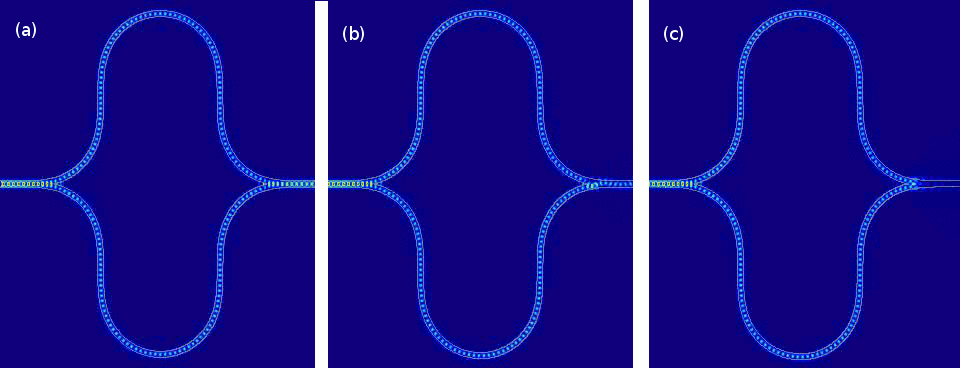 Simulations of the integrated Mach-Zehnder interferometer found in Lightmatter's neural-network accelerator show three different conditions whereby light traveling in the two branches of the interferometer undergoes different relative phase shifts (0 degrees in a, 45 degrees in b, and 90 degrees in c).
Lightmatter
Simulations of the integrated Mach-Zehnder interferometer found in Lightmatter's neural-network accelerator show three different conditions whereby light traveling in the two branches of the interferometer undergoes different relative phase shifts (0 degrees in a, 45 degrees in b, and 90 degrees in c).
Lightmatter
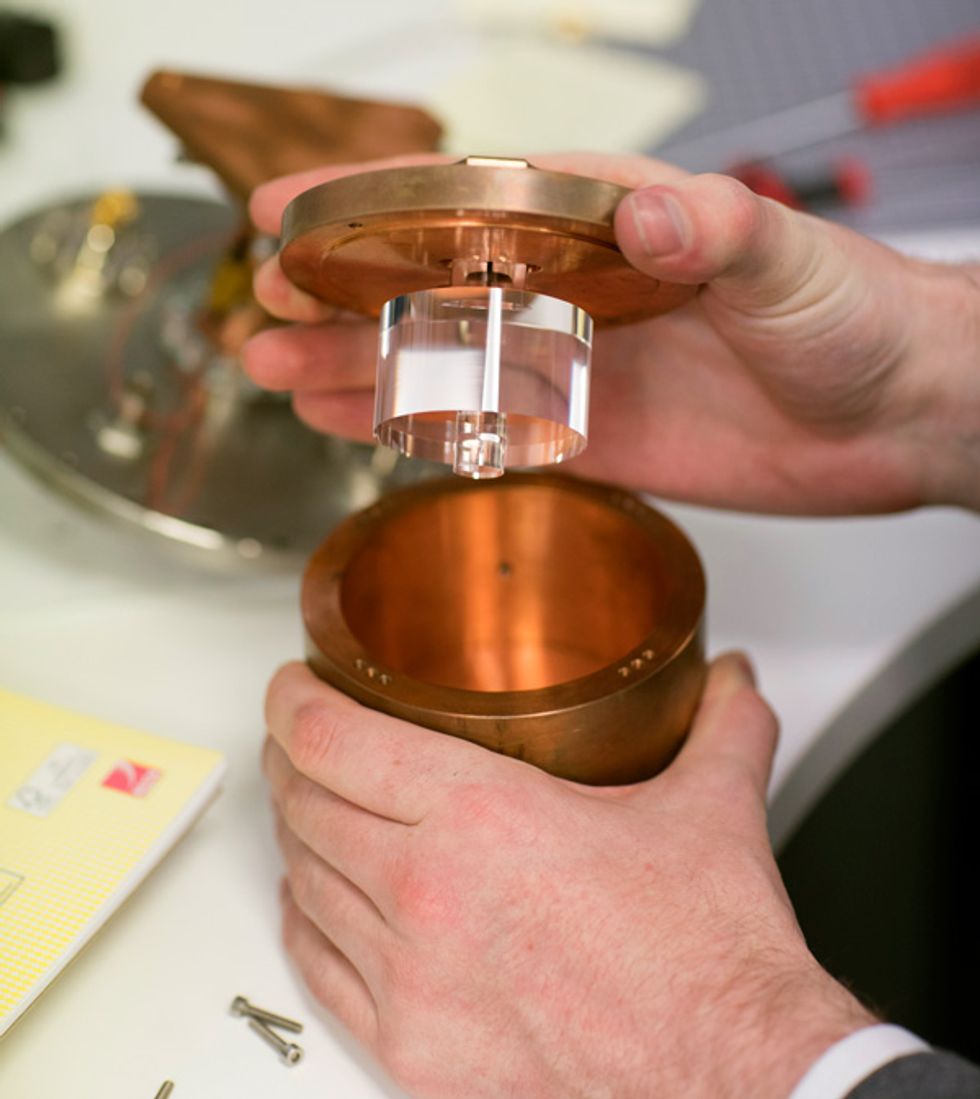
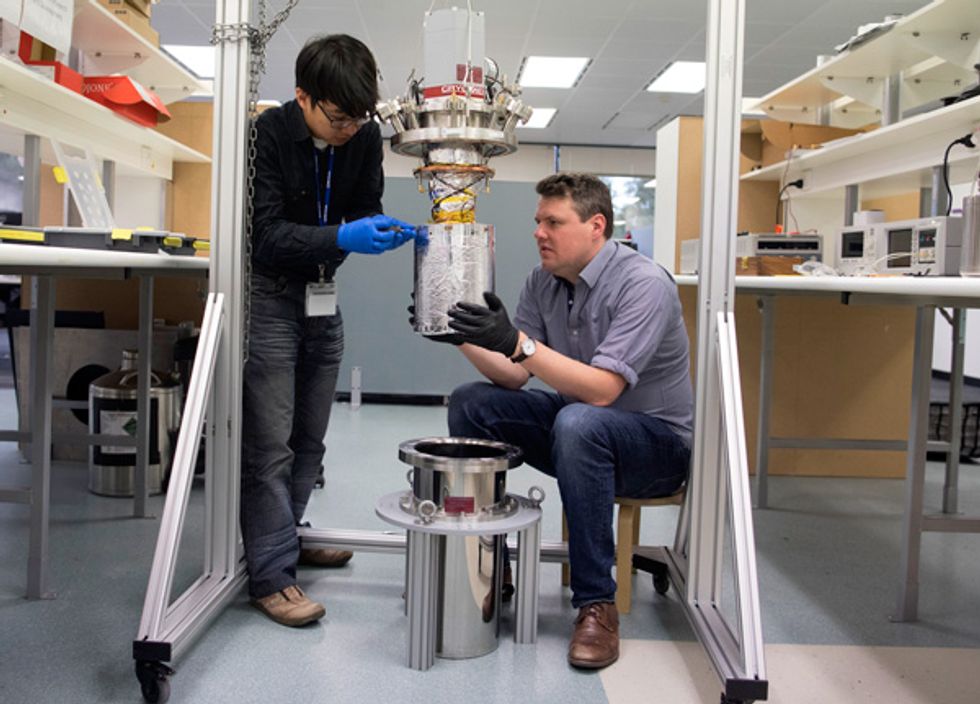
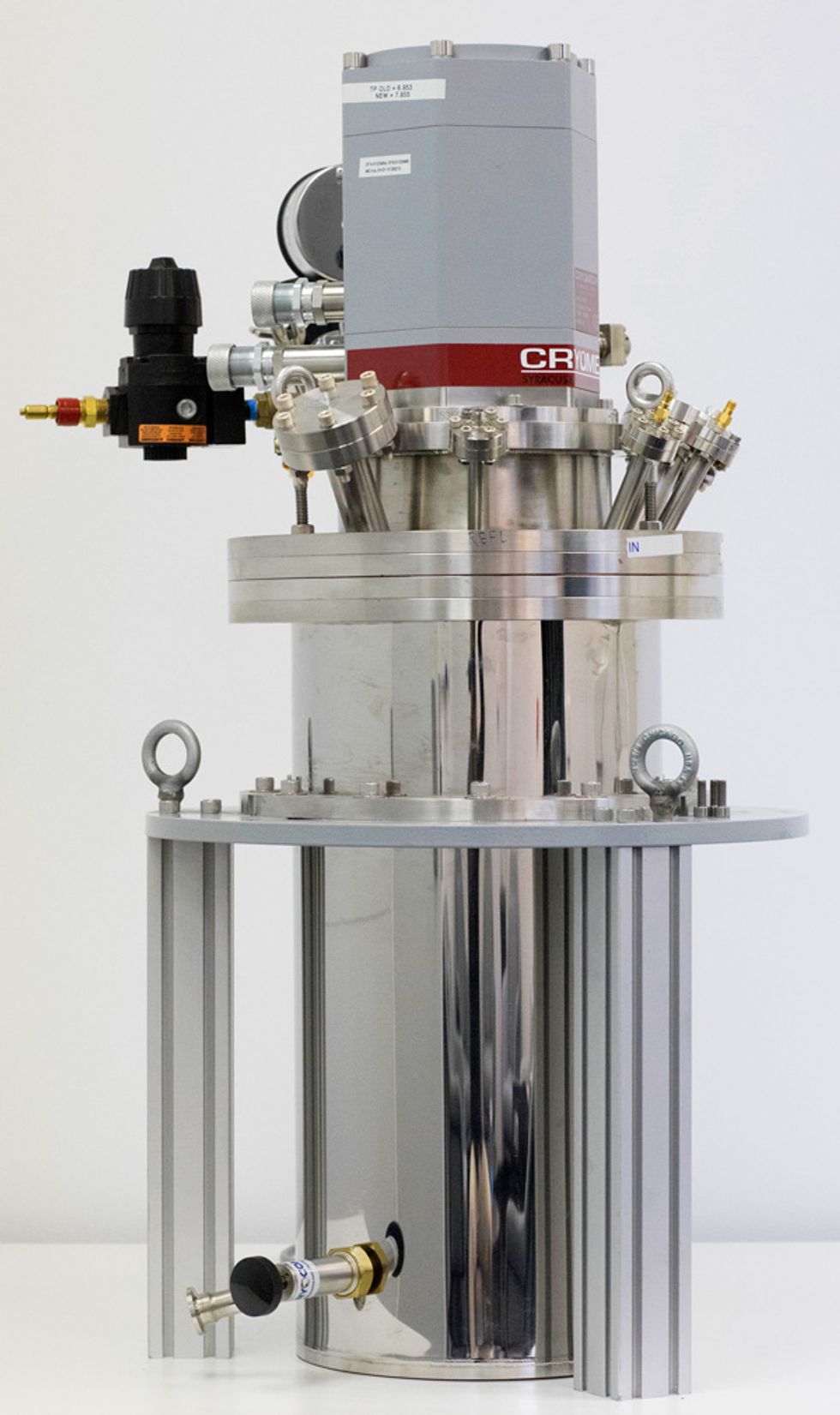 The sapphire crystal fits into a metal chamber (top), which is then enveloped in a cryogenic cooler and lowered into a vacuum can by engineers Ka Wu (middle, left) and Fred Baynes. Result: a cryogenic sapphire clock.
Brent Lewin/Redux
The sapphire crystal fits into a metal chamber (top), which is then enveloped in a cryogenic cooler and lowered into a vacuum can by engineers Ka Wu (middle, left) and Fred Baynes. Result: a cryogenic sapphire clock.
Brent Lewin/Redux
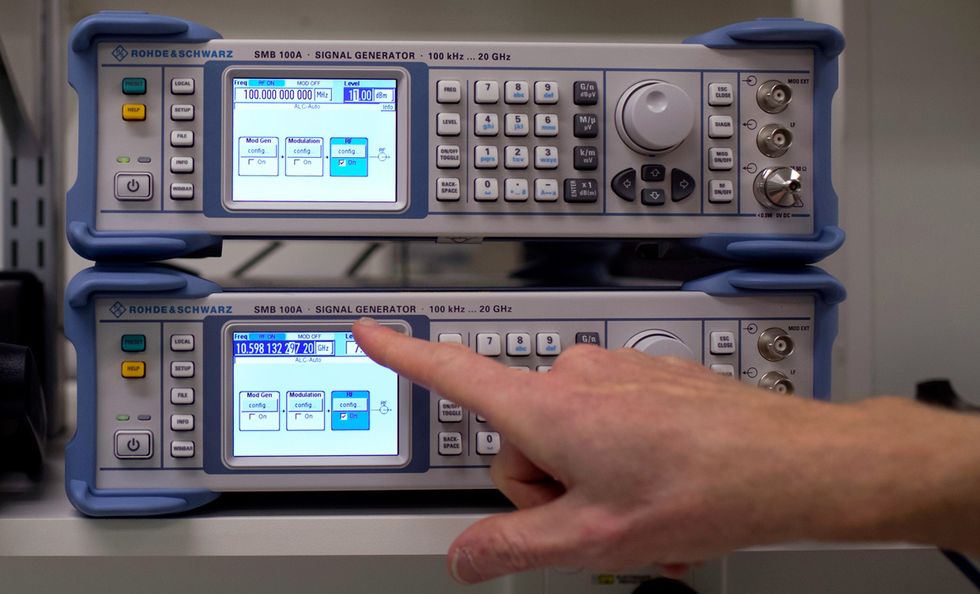 A frequency counter displays a reading for a cryoclock in a laboratory in Adelaide.
Brent Lewin/Redux
A frequency counter displays a reading for a cryoclock in a laboratory in Adelaide.
Brent Lewin/Redux
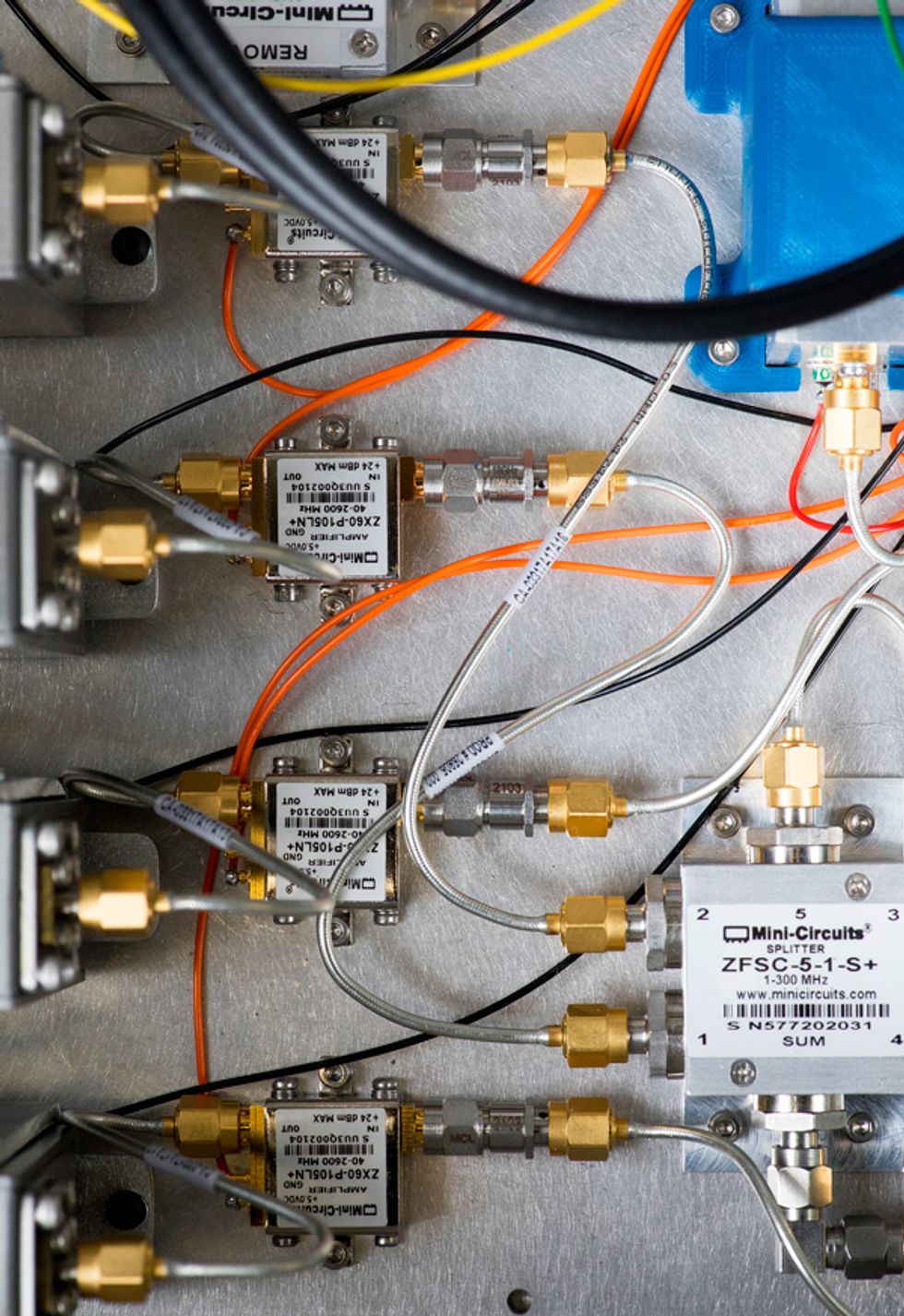
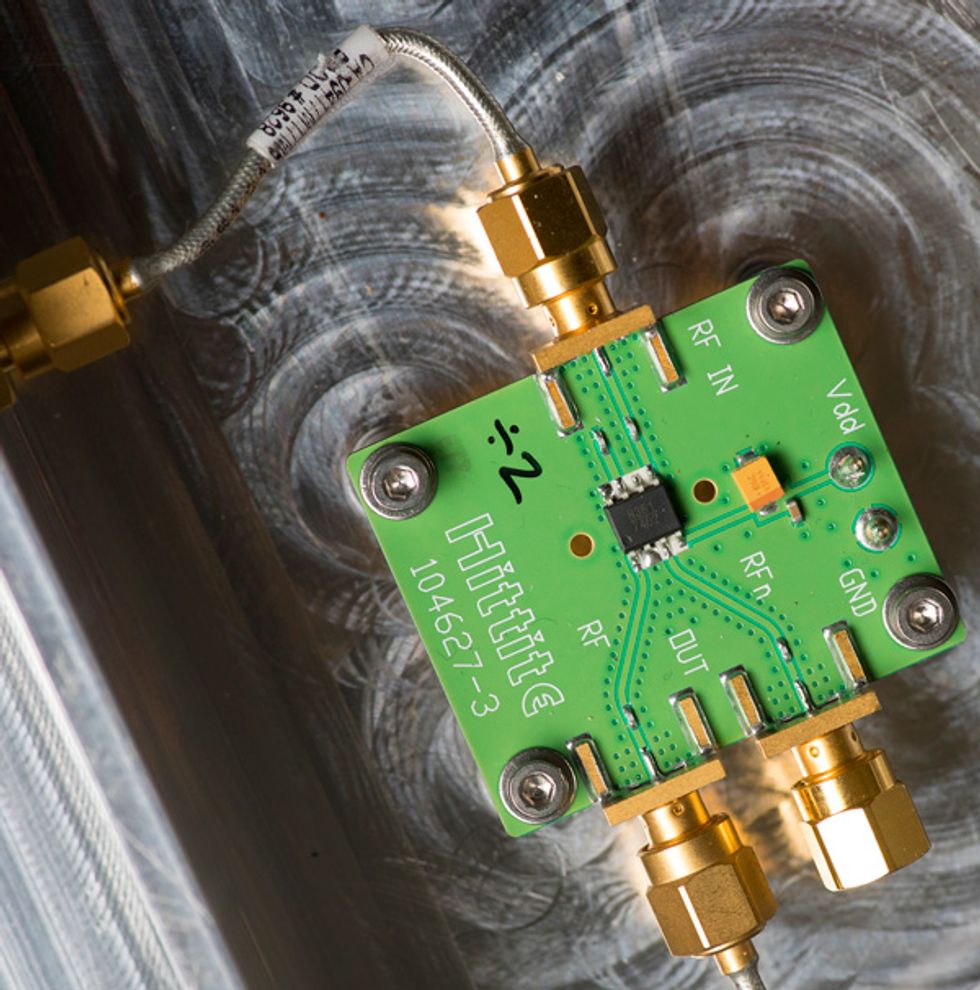
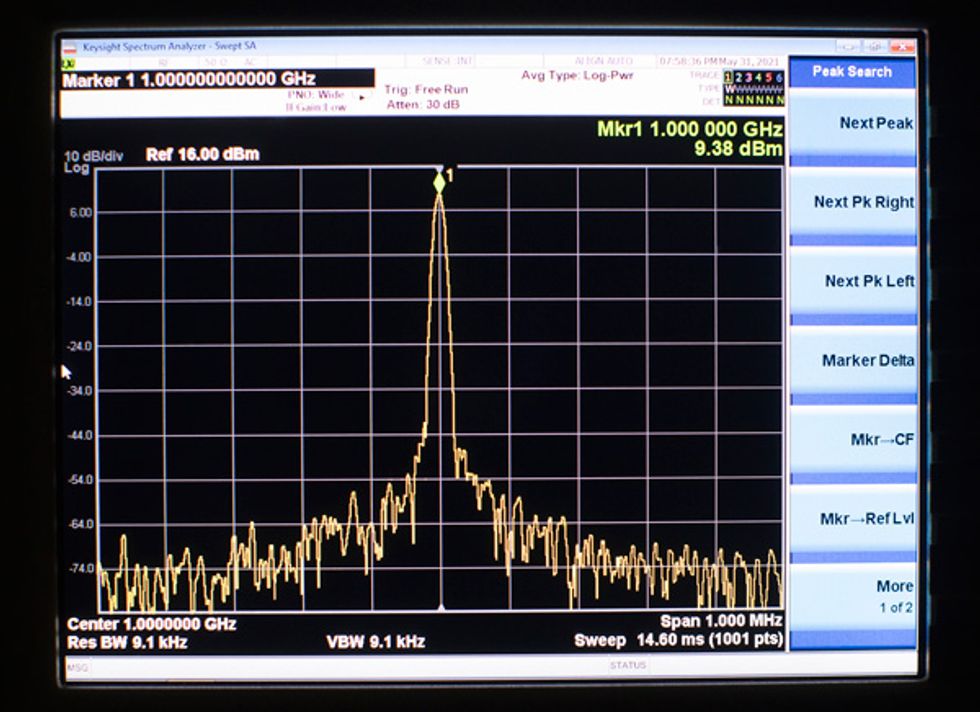 The wires (top) and the circuitry (middle) form part of the synthesizer module of the cryoclock system. One of the signals is displayed on a screen (bottom).
Brent Lewin/Redux
The wires (top) and the circuitry (middle) form part of the synthesizer module of the cryoclock system. One of the signals is displayed on a screen (bottom).
Brent Lewin/Redux
 The Sapphire Clock technology greatly improves the over-the-horizon reach of the Jindalee Operational Radar Network (JORN) in Longreach, Queensland. Standing among the antennas are (left to right) Fred Baynes, Andre Luiten, Martin O'Connor, and Waddah Al-Ashwal.
QuantX Labs
The Sapphire Clock technology greatly improves the over-the-horizon reach of the Jindalee Operational Radar Network (JORN) in Longreach, Queensland. Standing among the antennas are (left to right) Fred Baynes, Andre Luiten, Martin O'Connor, and Waddah Al-Ashwal.
QuantX Labs
 Heather Gorr
Heather Gorr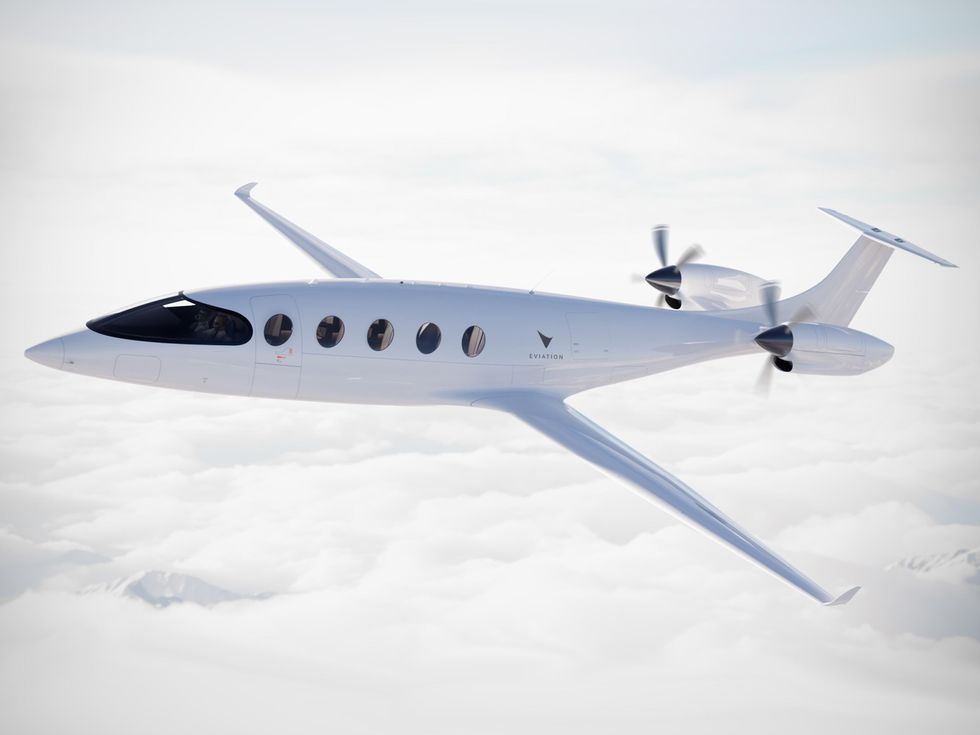 This is a conceptual rendering of Eviation's Alice, the first commercial all-electric passenger plane, in flight.Eviation
This is a conceptual rendering of Eviation's Alice, the first commercial all-electric passenger plane, in flight.Eviation